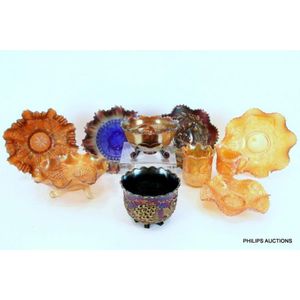
Fenton 'Horse Medallion' Nut Bowl and 9 Carnival Glass Items
A group of ten carnival glass items, comprising a Fenton 'Horse Medallion' nut bowl in amethyst, with three ball feet, together with 9 other carnival glass items from the estate of a prominent Australian collector. Height 6 cm, diameter 22.5 cm, and…

Carnival Glass Collection: Fenton Plate and 9 Other Items
A group of ten carnival glass items, comprising a Fenton marigold footed plate in 'Stag and Holly' pattern (Purch. $610 in 1995), together with 9 other carnival glass items from the estate of a prominent Australian collector. Height 4.5 cm, diameter 23.5…

Collection of Eleven Carnival Glass Items from Australian Collector
A group of eleven carnival glass items, comprising a Fenton 'Panter' footed bowl in aqua, with ruffled edge and raised on three ball feet, together with 9 other carnival glass items from the estate of a prominent Australian collector. Diameter 23.5 cm,…

Collection of Eleven Carnival Glass Items from Australian Collector
A group of eleven carnival glass items, comprising a Fenton 'Water Lilly' together with 9 other carnival glass items from the estate of a prominent Australian collector. Height 7.5 cm, diameter 24 cm, and smaller

Collection of Ten Carnival Glass Items from Australian Collector
A group of ten carnival glass items, comprising a Fenton 'Stag and Holly' amethyst footed bowl, raised on three spatula feet, together with 9 other carnival glass items from the estate of a prominent Australian collector. Height 8 cm, diameter 19 cm, and…

Carnival Glass Collection from Prominent Australian Collector Estate
A group of ten carnival glass items, comprising a Fenton marigold 'Butterfly and Berry' water jug and eight tumblers (Purch $745 in 1999), together with 9 other carnival glass items from the estate of a prominent Australian collector. Height 23.5 cm,…
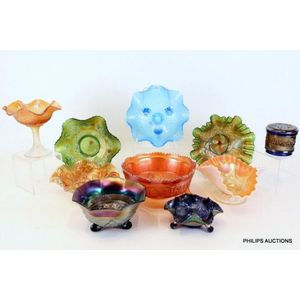
Celeste Blue Fenton 'Grape and Cable' Bowl with 9 Others
A group of ten carnival glass items, comprising a Fenton 'Grape and Cable' bowl in celeste blue, with ruffled edge and raised on three ball feet, together with 9 other carnival glass items from the estate of a prominent Australian collector. Height 10 cm,…
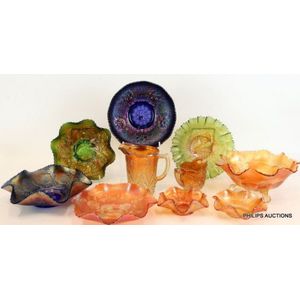
Carnival Glass Collection: Fenton 'Cherry Chain' Bowl and More
A group of ten carnival glass items, comprising a Fenton 'Cherry Chain' bowl in blue, with orange tree exterior, raised on a collar base, together with 9 other carnival glass items from the estate of a prominent Australian collector. Height 11 cm,…

Fenton 'Dragon & Strawberry' Bowl & 9 Carnival Glass Items
A group of ten carnival glass items, comprising a Fenton 'Dragon & Strawberry' footed bowl in marigold, with ruffled edge, on three ball feet, together with 9 other carnival glass items from the estate of a prominent Australian collector. Height 8.5 cm,…

Fenton's Iridescent Little Flowers Carnival Glass Bowl
Purple iridescent carnival glass 'Little Flowers' bowl by Fenton

Iridescent Persian Medallion Bowl by Fenton
Blue iridescent carnival glass 'Persian Medallion' bowl gilding by Fenton

Fenton Marigold Butterfly Berry Carnival Glass Bowl
Marigold carnival glass 'Butterfly berry' three foot bowl by Fenton

Fenton's Iridescent Purple Carnival Glass Bowl - Vintage
Purple iridescent carnival glass 'Vintage' bowl by Fenton

Iridescent 'Cherry Chain' Bowl by Fenton
Green iridescent carnival glass 'Cherry Chain' bowl by Fenton

Green Iridescent Fenton Carnival Glass Footed Bowl
Green iridescent carnival glass 'Persian Medallian' footed bowl by Fenton

Fenton's Iridescent Lotus and Dragon Carnival Bowl
Purple iridescent carnival glass 'Lotus and Dragon' three footed bowl by Fenton
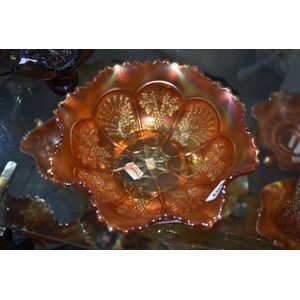
Fenton Marigold Peach and Grape Carnival Glass Bowl
Marigold carnival glass 'Peach and Grape' three foot bowl by Fenton

Fenton's Blue Iridescent Lotus and Grape Shallow Bowl
Blue iridescent carnival glass 'Lotus and Grape' three foot shallow bowl by Fenton
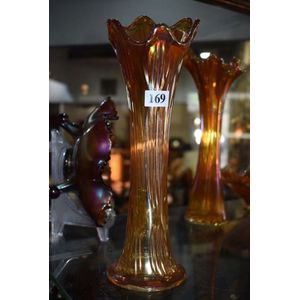
Fenton's Marigold Diamond Rib Tall Carnival Glass Vase
Marigold carnival glass 'Diamond Rib' tall vase by Fenton

Fenton Amethyst Grape and Cable Carnival Glass Bowl
Amethyst carnival glass 'Grape and Cable' three foot bowl by Fenton

 Loading more...
Loading more...